Football: cards and sanctions
Red cards, yellow cards, penalty kicks: a summary of the main football rules
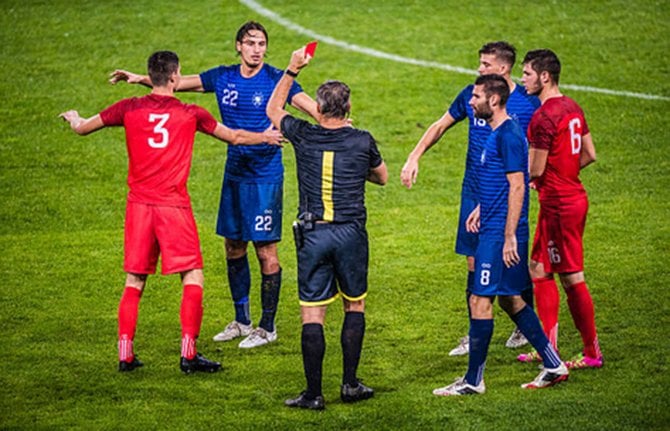
Easy explanations and curious facts about sanctions in football
The sanction takes place immediately: this definitely applies to football, especially if the referee has not slept well. In what cases does the referee give a yellow card? How long has the red card existed for? And what is the difference between a penalty and a free kick? We'll get to the bottom of all these questions and many more here.
When the ref goes for his pocket...
The players are still running after the ball when suddenly a shrill sound comes from the referee's whistle. The ref, totally impartial, walks towards the players with a grim expression. Red or yellow? That is the question! We take a closer look at the card rules in football and clarify when which card is used.
The yellow card
If the referee shows the yellow card, it is a warning. In football, the yellow card is shown when players have violated the rules of the game too often or too violently, or have shown unsportsmanlike behaviour.
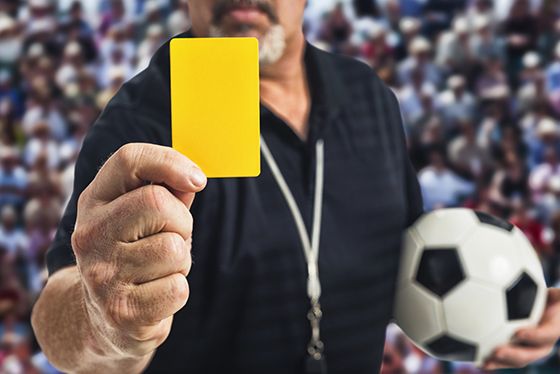
When does the ref show a yellow card?
More specifically, a player is given a yellow card when he:
• commits a technical foul.
• commits a severe foul.
• breaks the rules repeatedly.
• doesn't observe the correct distance during a throw-in, corner or free kick.
• delays the game from starting again after an interruption.
• comes on or off the pitch without the referee giving him permission.
• protests against the referee or doesn't respect him (if he insults the ref, he will receive a red card).
Consequences of a yellow card
A yellow card hasn't really got direct consequences on a player - he should, however, pay attention to the way he behaves. Indeed, two yellow cards automatically lead to a red card. This means he has to leave the pitch and his team cannot substitute him. Furthermore, the player must skip the following game.
Did you know? In the past, as a player got a red card following two yellow cards, he had to go to the sports court and could be suspended for more than one match.
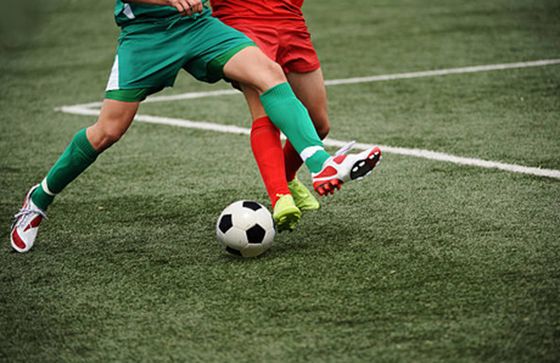
Suspension
If a player collects several yellow cards in different games within a competition or a period of time determined by the league, he will get suspended. Depending on the tournament and the league, suspension is handled differently:
- In World and European Cups, two yellow cards are sufficient to suspend a player for a match.
- In the German Bundesliga, a suspension follows five warnings.
- Other European leagues each have their own rules: in the top championships in Italy and Switzerland, a player is suspended after the fourth yellow card; in the Premier League in England there is a suspension if the player collects five yellow cards between the first matchday and 31st December. If the player does not receive the fifth yellow card until January, he will not be suspended. In the Netherlands, yellow cards can even be counted into the following season.
Did you know? The suspension in the Bundesliga is probably due to the "yellow card king" Walter Frosch, who had achieved a total of 18 or 19 yellow cards in 37 games in the second league 1976/77 season. As a result, suspension was introduced by the DFB (Deutscher Fußballbund) for the 1979/80 season.
The red card
In football, the red card stands for a sending-off and thus represents the most severe penalty. The referee shows the red card for severe violations of the football rules. The player must then leave the pitch immediately and cannot be substituted, i.e. his team will be outnumbered for the rest of the match. Furthermore, the player concerned is usually suspended for at least one match.
The referee shows the red card if a football player:
• commits a severe foul.
• becomes violent.
• insults somebody.
• prevents the opponent from clearly scoring with a so-called "professional foul" (which is a deliberate act of foul play).
Did you know? The referee can show a red card even after the end of a game, for example if players become violent on their way into the changing room.
After a red card, the match may resume only after the referee has blown his whistle. If the players do not wait for the clearance and play the ball too early, the referee may show a yellow card.

Football history: since when do red and yellow cards exist?
Red and yellow cards haven't always been around - they were introduced for the first time for the 1970 World Cup. During the 1966 World Cup, there was turmoil on the pitch between Argentina and England players, which led to the expulsion of some players. Two players from both teams couldn't understand what the referee, Ken Aston, was saying. The ref therefore decided to use red and yellow cards, like a traffic light, to indicate how serious certain actions were.
The combination of yellow and red cards was first introduced in 1991.
Did you know? A blue card also exists in football, which is used for Austrian youth categories to show a time penalty.
Fun facts about red and yellow cards
Football history has been marked by many (inglorious) records linked to red and yellow cards, some of which deserve to be told. Here they are!
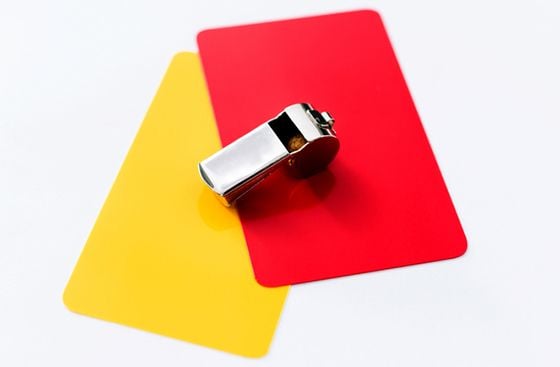
The most cards given at a World Cup? There are two games to remember, the first in 2002 during Germany vs Cameroon (14 yellow cards and 2 red cards) and the second in 2006 during Portugal vs the Netherlands (12 yellow cards and 4 red cards).
• Torsten Wohlert, Fernando Meira and Maurizio Gaudino have the most red cards in the history of the German Bundesliga, with 5 red cards each.
• Argentinian record: in March 2011, referee Damien Rubino gave the most red cards in one game, 36, during a fifth-division match. It wasn't just the players, but both trainers and everyone on the bench was involved. The reason? A very "inclusive" fight on the pitch.
• Due to a referee's mistake, football hero Josip Simunic saw three yellow cards during a game in the 2006 World Cup. The refereee didn't show him the red card after the two yellow cards. He only got a red card after the third yellow card in extra time.
• The record for the quickest red card in football history belongs to Cross Farm Park Celtic player Lee Todd. In a game in October 2000, he had to leave the pitch after two seconds. Why? He got scared when he heard the ref blowing the whistle and he whispered: "Fuck me, that was loud" right by where the referee was standing.
• The German "arse card" (Arschkarte): this is how a red card is called in German football jargon. The term dates back to 1970, the year in which red and yellow cards were introduced. In order not to show the wrong card, referees used to keep them in different pockets: the yellow one in the shirt, the red one in the back pocket of their shorts. This is probably why the expression still exists in German today.
The penalty kick
A penalty kick is also known as simply penalty, pen or penalty shoot.
A penalty kick is defined as a shot taken at a distance of 11 meters from the goal.
When is there a penalty kick?
A penalty kick is given by the referee in case of a foul or handball on the part of a defender in the penalty area.
Execution of a penalty kick
After the referee has given a penalty, a player from the attacking team shoots the ball at the opposing goal from a distance of 11 meters. Until the moment the shooter touches the ball, no player other than the shooter and goalkeeper may be in the penalty area. The goalkeeper must not leave the goal line during the penalty kick. Only after the shooter has touched the ball may other players enter the penalty area and the goalkeeper leave the goal line. In this case, an additional shot and the intervention of other players is allowed. The player taking the penalty kick may only touch the ball again after it has been touched by another player.
A penalty kick is normally an excellent goalscoring opportunity. In 75% to 80% cases of penalty kicks the shooter is successful, and during World Cups the quota is even higher than 80%.

Don't be mistaken: The penalty kick must not be confused with a penalty shoot-out. The latter is not a penalty for a rule violation, but a procedure to determine a winner in a game.
Fun facts about penalties
As clear as the rules seem to be for penalties, some players have been pretty inventive in the past. In 2016 Lionel Messi and Luis Suarez caused a stir with a penalty kick trick: in FC Barcelona's game against Celta Vigo, Messi took the penalty - but instead of kicking the ball in the direction of the goal, he passed it to his colleague Suarez as a cross pass. Suarez shot the ball into the net and made it 6-1 for Barcelona.
Messi's penalty kick is listed as missed in official statistics. The execution of the penalty shot, however, is considered as regular despite all discussions and protests that followed Messi's unusual style of play.
Did you know? Messi and Suarez were not the first footballers to convert a penalty shot in this way. In 1982, Barca legends Johan Cruyff and Jesper Olsen caused a stir with such a trick.
The free kick
The free kick in football punishes a foul, unsportsmanlike conduct or any other breach of the rules: if the rules do not provide for any other form of resumption, such as a penalty kick, the opposing team is awarded a free kick. A distinction is made between a direct and an indirect free kick.
Direct free kick
A direct free kick can be directly kicked into the opponent's goal by the player taking the kick (without touching another player). The referee decides on a direct free kick if one of the following cases occurs during the match:
• (attempted) kicking of opponent
• (attempted) tripping
• (attempted) hitting of opponent
• (attempted) spitting of opponent
• holding
• jostling
• kicking
• jumping onto another player
• pressing
• intentional handball
The direct free kick is taken from where the offence was committed. The ball must lie still on the ground.
All players of the defending team must be at least 9.15 metres from the ball or on their own goal line between the posts. They often stand in a line (called a wall or free-kick wall) to block a shot at the goal.
To mark the position of the ball and the minimum distance between the wall and the ball, referees spray a special foam on the ground, which disappears after about 45 to 120 seconds. The free kick spray was an Argentinian amateur footballer's idea: he was annoyed that the wall came too close to him during a free kick and thus prevented a goal. The spray has been used at South American football matches since 2000, and FIFA also used it at the 2014 World Cup in Brazil - but it remains controversial.
The player taking the free kick may only touch the ball again after it has been touched by another player.
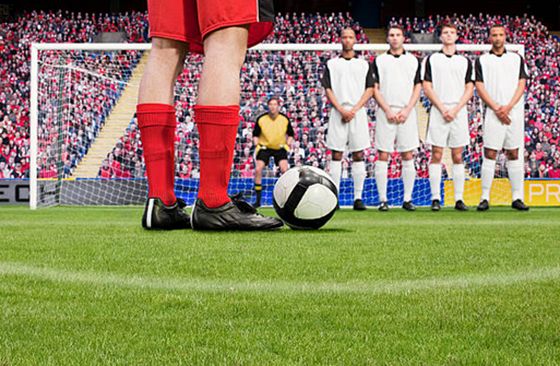
Indirect free kick
In an indirect free kick, a goal can only be scored if, after the free kick has been taken, another player touches the ball before it lands in the back of the net. However, if the ball goes into the net directly after the indirect free kick, it doesn't count.
The referee shall decide, inter alia, on an indirect free kick in the following scenarios:
• in case of offside
• in case of violation of the backpass rule
• if a player plays dangerously
• if a player obstructs the run of his opponent (as long as there is no fight for the ball)
• if a player obstructs the goalkeeper from passing the ball to the defender with his hands
• if the ball is played twice by the same player during a restart
• in case of simulation
• in the event of unsportsmanlike conduct such as insults to opponents or the referee
• if the goalkeeper holds the ball in his hands for more than six seconds before passing it
Differences between penalties and free kicks
A penalty kick and a free kick differ in that, in a penalty kick, the ball is played from the penalty spot, while in a free kick it is played from where the offence occurred.
Did you know? If a player commits a rule violation in his own penalty area that would be followed by a direct free kick, the referee must decide on a penalty kick.
More football in the owayo magazine
Wanto to know more about football rules? You can read more about why it is forbidden to take off your jersey. Or maybe you are interested in how to plan a proper football training session.
Exciting facts about football can be found in our interactive timeline on History of Football. Why don't you go and have a look?
Photo credits: Title of picture: © gettyimages/ simonkr; Picture 1: © gettyimages/ cmannphoto; Picture 2: © gettyimages/ cmannphoto; Picture 3: © gettyimages/ Dmytro Aksonov; Picture 4: © gettyimages/baona; Picture 5: © gettyimages/ Dmytro Aksonov; Picture 6: © gettyimages/ Image Source